
- Amazon Rainforest
- Barranquilla
- Caribbean Coast
- City Comparisons
- Coffee Region
- Pacific Sea
- Santa Marta
- Colombian Culture
- Expat Stories
- Sports & Fitness
- Neighborhoods
- Security and Safety
- Transportation
- Argentinian Food
- Brunch and Breakfast
- Colombian Food
- Gastronomic Markets
- Italian Food
- Mexican Food
- Peruvian Food
- Sports Bars
- Steakhouses and Ribs
- Vegetarian Food
- Attractions
- Events & Holidays
- Hiking & Trekking
- Kid Friendly
- Learn Salsa
- Learn Spanish
- Movies & Theater
- Parks & Plazas
- Buying Property
- Cost of Living
- Furnished Apartments
- Health Insurance
- Jobs & Business
- Visas (in Spanish)
- Visas & lawyer Immigration
- Real Estate


Popular Keywords
No Record Found
- July 24, 2023
- 64 Comments
Guide to Travel with a Pet to Colombia: Travel with a Dog or Cat – Update 2023
It is relatively easy to travel with a pet to Colombia. You can travel to Colombia with a dog, cat or other household pet with only a few requirements.
Colombia does not require an import permit for personal pets from any country. And there is no pet microchip required for Colombia.
Several Medellin Readers asked about travel with a pet to Colombia. So, we we now have an up-to-date guide.
Also, be careful, as many websites in English I found on the Internet have inaccurate, incomplete or out-of-date information about travel with a pet to Colombia.
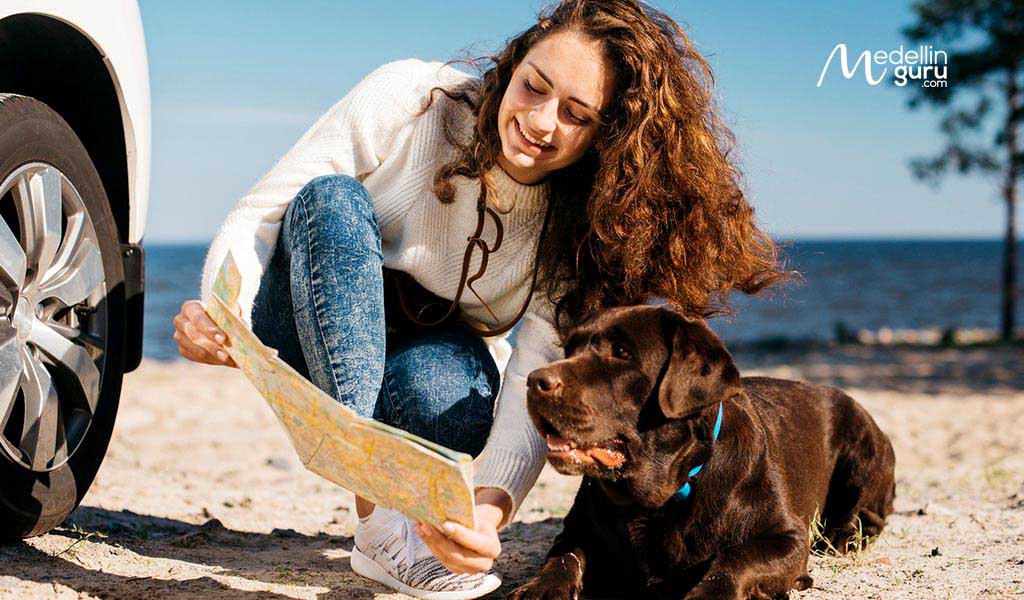
Travel with a pet to Colombia
What Documents are Needed to Travel with a Pet to Colombia
Within 10 days of travel, an accredited veterinarian from the country of origin must complete a veterinary health certificate for your pet. If you are traveling from the U.S. or Canada, the veterinary health certificate must also be endorsed by the USDA in the U.S. or CFIA in Canada.
In the U.S, this veterinary health certificate is the APHIS Form 7001 . And Canada has a trilingual Animal Health Certificate in English, French and Spanish that should be used.
In the U.S., the USDA has APHIS Veterinary Services Endorsement Offices in all the states where you can get health certificates and rabies certificates endorsed. Note that this endorsement should be from the state you a traveling from to Colombia.
You send your veterinary health certificate and rabies certificate that are endorsed by the USDA and returned to you within 48 hours. Keep in mind the 10-day limit. So, you don’t have much time to send this and get it back. So, use express mail. Canada’s CFIA works similarly and endorses and returns health certificates within 48 hours.
In addition, your pet must be vaccinated and you need a vaccination certificate with a record of vaccinations.
To enter Colombia with a pet, your cat or dog must be vaccinated for rabies more than 30 days before travel to Colombia and before the vaccination expires. Also, Colombia does honor the 3-year vaccine.
Dogs reportedly must also be vaccinated against Distemper, Hepatitis, Leptospirosis and Parvovirus. And cats must be vaccinated against Feline Rhinotracheitis, Calicivirus and Feline Panleukopenia. And if entering Colombia from countries other than Ecuador, Peru and Bolivia, your pet should also be vaccinated against Parainfluenza and Coronavirus (note this is Canine Coronavirus, not the coronavirus or COVID-19 pandemic impacting humans).

Avianca 767-200 at El Dorado Bogotá Airport, photo by Carlos Colina
Check with the Airline to Travel with a Pet
Airlines only allow a specific number of pets on each flight and the spots fill up. So, call and make a reservation for your pet. And most airlines require at least a 24-hour notice of a pet traveling with you. Also, it isn’t free to travel with a pet. In addition, don’t forget pet calming aids.
Pets can travel in the airplane cabin or air cargo, depending on the size. Large dogs can be more complicated to travel with, as not all airlines will take large dogs. So, make sure to check with the airline about their pet regulations.
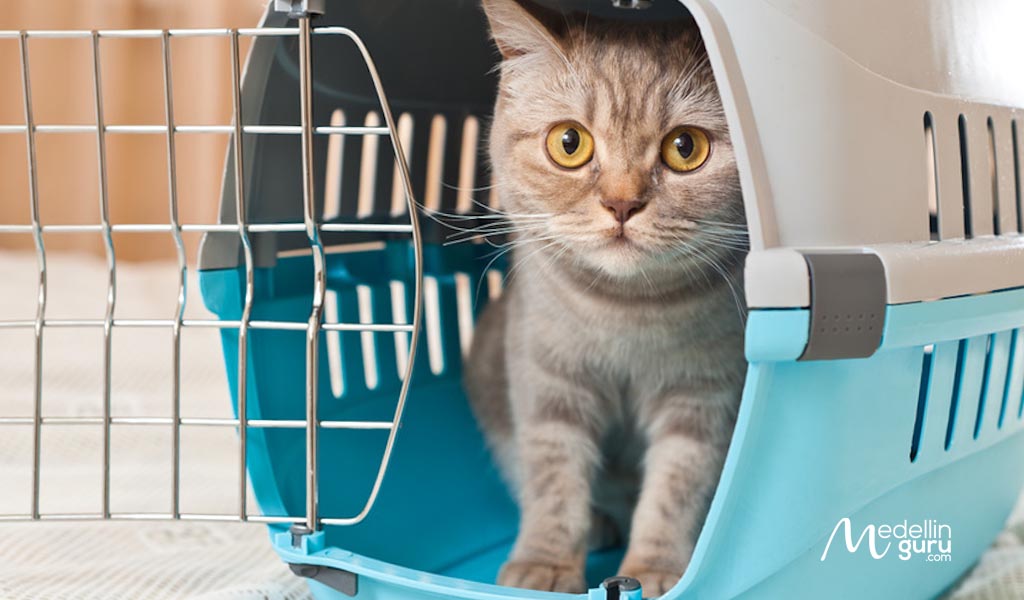
Check with the airline about their pet regulations – like pet carrier size and weight restrictions
Pet Rules of International Airlines that Fly Non-Stop to Medellín
The following are the pet rules of several airlines with international non-stop flights to Medellín in Colombia:
- American Airlines – permits pet carries in the cabin of up to 19″L x 13″W x 9″H and a maximum weight of 20 pounds (10 kilograms) including the pet and carrier. American Airlines also does transportation of pets as checked baggage depending the the aircraft (checked pets can’t travel on Airbus A321, A321S, A321H, A320 and A319). In addition, American Airlines supports checked pets of up to 100 pounds including the pet container. See American Airlines website for more information about travel with a pet.
- Avianca – permits pets of up to 22 pounds (10 kilograms) in the cabin with a charge of $135 from the U.S. and Canada. In addition, Avianca permits pets weighing up to 110 pounds (50 kilograms) in the hold for flights of less than four hours with a charge of $210 from the U.S. or Canada. See Avianca’s website for more information about travel with a pet.
- Copa Airlines – permits pet carries in the cabin of up to 11″W x 18″D x 11H” and a maximum weight of 20 pounds (10 kilograms), including the pet and carrier. Copa does not transport pets as checked baggage. See Copa’s website for more information about travel with a pet.
- JetBlue – permits pet carriers in the cabin of up to 17″L x 12.5″W x 8.5″H and a maximum weight of 20 pounds (10 kilograms), including the pet and carrier. Also, JetBlue charges a pet fee of $125 each way. AndJetBlue does not transport pets as checked baggage. See JetBlue’s website for more information about travel with a pet.
- Spirit – permits pets traveling in the cabin with a limit of a pet carrier of 18″ L x 14″ W x 9″ H with a maximum weight of 40 pounds (18 kilograms) for the pet carrier and pet. And Spirit permits only four pet carriers per flight and Spirit charges a pet fee since $110 each way. Also, Spirit does not transport pets as checked baggage. See Spirit’s website for more information about travel with a pet.
In addition, Bogotá has non-stop flights from the U.S. by Delta and United Airlines. Delta will transport larger pets as cargo and United Airlines also transports larger pets as cargo.
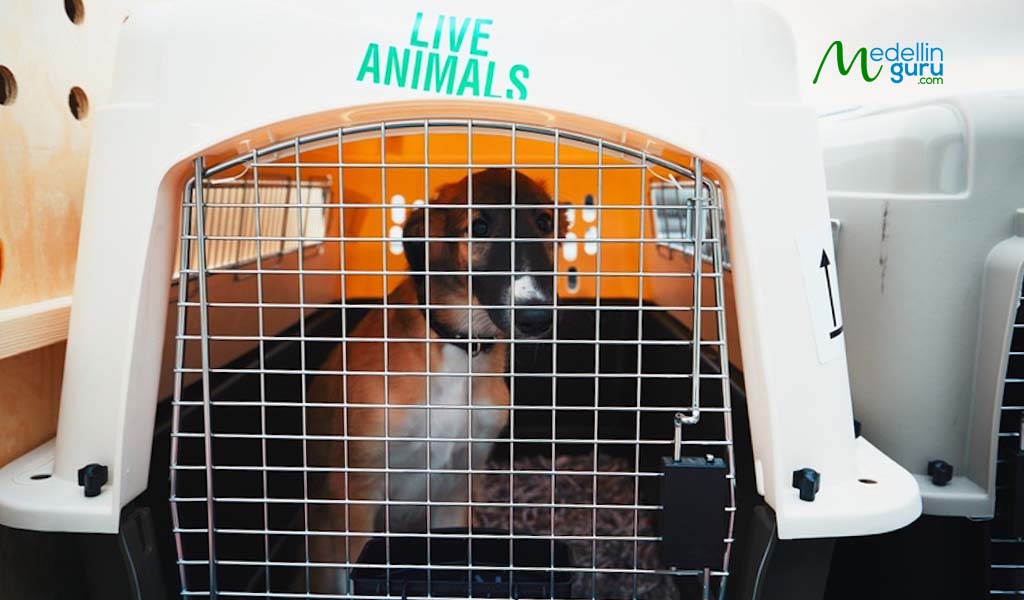
Avianca permits pets weighing up to 44 pounds (20 kilograms) in the hold for flights of less than 4 hours
Visit an ICA office at the Airport in Colombia
When you arrive in Colombia make sure to declare your pet. And upon arrival, get your luggage and proceed to the ICA office with your luggage, pet, heath certificate and vaccination record and a credit/debit card to pay the ICA fee.
All ports of entry into Colombia (airports, border entries and ports) will have an Instituto Colombiano Agropecuario (ICA) office. This is the Colombian agency that handles pet and other animal importation into Colombia and also food safety and agricultural health.
When you arrive, visit the ICA office they will be looking for two documents:
- Health certificate – issued by the official veterinary service of the country of origin within 10 days prior to arrival. The certificate should describe the animal and certify that is has been examined and is free of infectious and parasitic diseases and without the presence of fresh wounds.
- Vaccination certificate – this must include the current vaccination plan according to age and species and a list of vaccinations including product names, batch numbers and dates of vaccinations.
According to ICA’s website, these documents must be original and translated to Spanish if not in Spanish. But two expats I talked to recently said the documents didn’t need to be translated. And there is no need for an apostille.
After the document inspection, ICA will perform a physical inspection of the animal to verify the health condition of the animal.
If the documents you have are accepted and the animal passes the physical inspection, a Certificate of Inspection (CIS) will be issued and the animal will be let in.
And the cost is more than 50,000 pesos (according to the case). This is for Monday to Friday between 8 am and 5 pm. Other hours have a surcharge except at the El Dorado International airport in Bogotá, which does not have a surcharge for extended hours and it operates 24 hours.
Also, you can pay this fee to ICA with a credit or debit card (Visa or Mastercard only). And no cash is accepted by ICA. But you can pay in cash at several banks including Banco Agrario, Bancolombia, Banco de Occidente and Davivienda. ICA has information for paying at a bank.
Dogs and cats and other household pets that do not meet the requirements for importation must comply with a period of post-entry home quarantine in Colombia, which includes two follow-up visits by an ICA official. And the cost becomes 537,572 pesos.
In addition, you can see the complete list of requirements for importation of dogs and cats into Colombia on the ICA website here (in Spanish) .

American Pit Bull Terrier is one breed not permitted.
Warning: Several Dog Breeds are Not Permitted in Colombia
Several dog breeds are not permitted to be bought to Colombia. The following dog breeds are considered potentially dangerous and cannot be brought to Colombia:
- American Pit Bull Terrier
- American Staffordshire Terrier
- Argentine Mastiff
- Brazilian Mastiff
- Bull Terrier
- Japanese Mastiff Tosa
- Neapolitan Mastiff
- Pit Bull Terrier
- Staffordshire Terrier
- Any crosses or hybrids of the above 11

Doberman is another breed not permitted
You can find many of these dog breeds in Colombia. But you are not permitted to bring these 11 dog breeds or crosses or hybrids into Colombia.

It is relatively easy to travel with a pet to Colombia
The Bottom Line: Travel with a Pet to Colombia – Travel with a Dog or Cat to Colombia
It is relatively easy to travel with a pet to Colombia. You only need a health certificate, rabies certificate and vaccination certificate. And the cost with ICA in Colombia when you arrive with your pet isn’t very much. It’s between 50.000 pesos ($12 ) if your documents are accepted and your pet passes a simple examination.
To travel with a pet to Colombia the fee will be higher with the airlines than the fee once you arrive in Colombia. The airlines charge at least $120 to travel with a pet to Colombia. Also, larger pets will be more difficult to travel with, as not all airlines support traveling with large pets.
In addition, Medellín is a pet-friendly city. For example, most shopping malls and some restaurants permit you to bring your dog.
Note that this article will be kept up-to-date, as things like pet importation regulations and costs change in Colombia each year.
In addition, “Can I travel with my pet to Colombia?” is question asked by some expats visiting Colombia or moving to the country. So, we included this question in our list of Medellín frequently asked questions (FAQ) .
Sign up for the Free Medellin Guru Newsletter – You can see all of the previous Medellin Guru weekly email newsletters and sign up here .
Editors note: updated on October 15, 2018 with addition pet transportation rules for American Airline and Copa Airlines to Medellín based on several readers questions about transporting larger pets from the U.S. and also pets from Panama.
Editors note: update on November 20, 2020 to clarify the vaccination for coronavirus in this article is for Canine Coronavirus, not COVID-19.
Editors note: updated on June 26, 2023 with new prices, rules about the pets and images.

Are you planning a trip to Colombia? The right health insurance is crucial, especially when applying for a Colombian visa....

Colombia requires health insurance when applying for visas, and we look at inexpensive travel insurance that meets the requirement, updated...

Explore Medellin Guru's Visa Services for seamless guidance on colombian visas. Our expert partner expatgroup.co offers comprehensive assistance for expats,...

Using a visa agency in Colombia can simplify obtaining a visa. Visa agencies are well-versed in the requirements and procedures....

How to Obtain a Colombia Retirement Visa – 2024 Update

Assist Card: Why is the Best Health Insurance for Colombian Visas

Travel Insurance: Meets the Health Insurance Requirement for Colombia Visas – 2024 Update
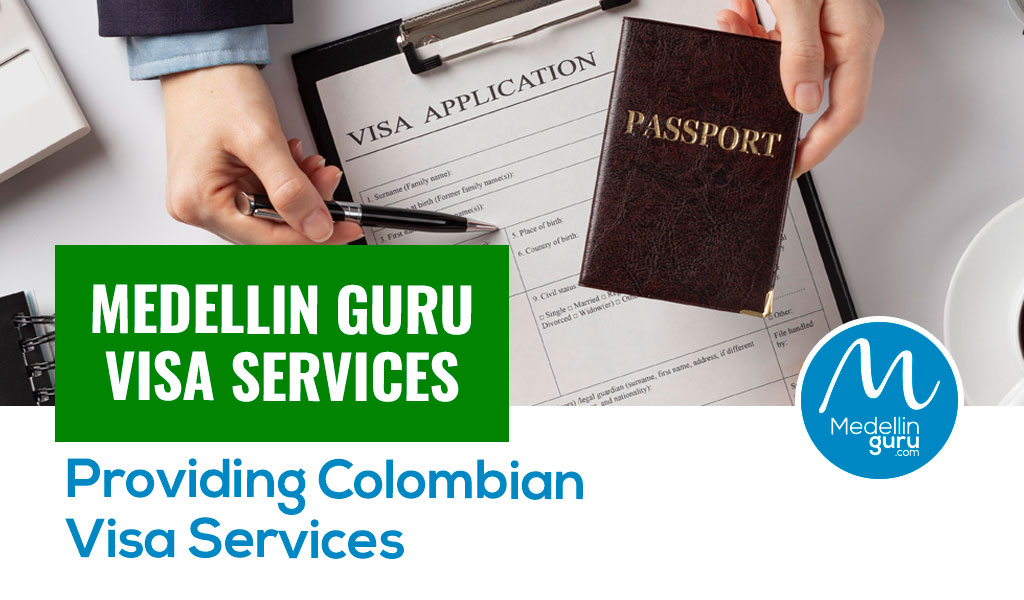
Medellin Guru Visa Service: Providing Colombia Visa Services

Get Insurance in Colombia

Insurance Service: Get Colombian Insurance From Our Insurance Agent – 2024 Update

How to be an Expat in Colombia: 12 Tips to be a Successful Expat
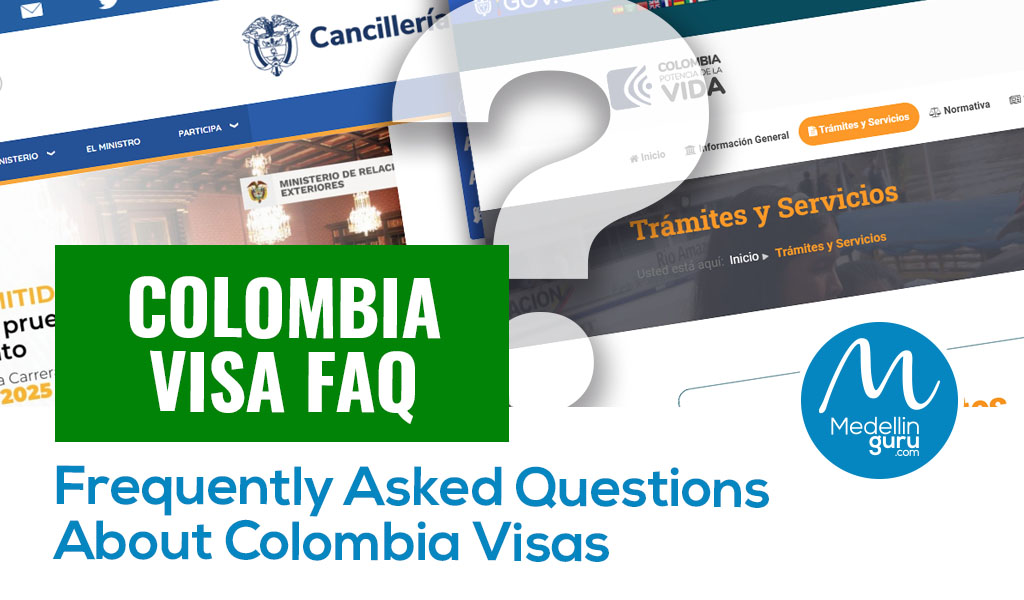
Colombia Visa FAQ: Frequently Asked Questions About Colombia Visas – 2024 Update
Last business-directory.

expatgroup.co is a dedicated team of professionals, who provide quality visa services to meet the needs of the expatriate community.

Modern and spectacular Studio, available for rent in one of the best locations in the city, where you will be...
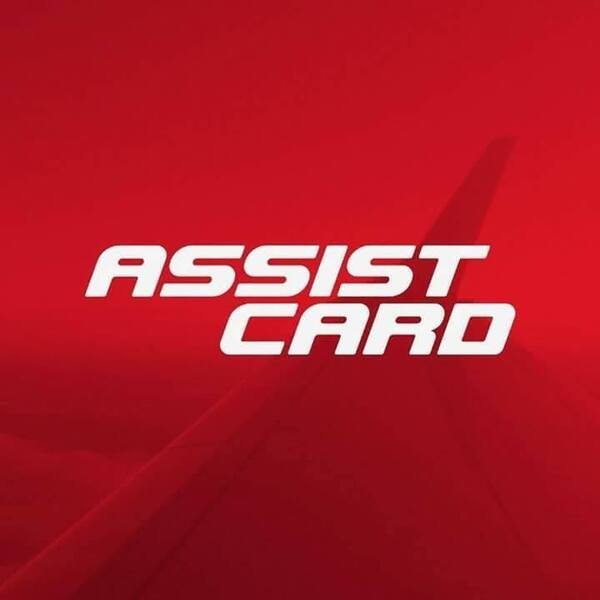
Health travel Insurance for expats in Colombia,AssitCard is multinational company dedicated to the provision of international assistance services with worldwide...

Real estate legal services for foreigners in Colombia: Transferring funds into Colombia, legal analysis and property background check, sales agreement,...

The Belmonte Penthouse

expatgroup.co

La Octava Maravilla Mirador

Apple Travel

Luxury Studio with Balcony-San Joaquin-Laureles

Assist Card

Real Estate by expatgroup.co

Luxury Studio-San Joaquin-Laureles

Medellin Airport to City
- Blogs Premium
- Live in Colombia
- Restaurants
- Selling Real Estate
- Things to Do
- Uncategorized
- Unfurnished Apartments
64 thoughts on “Guide to Travel with a Pet to Colombia: Travel with a Dog or Cat – Update 2023”
Hello, Thought I would follow up on my post with the info I have found. My sister in law spoke in person to an ICA rep at El Dorado in Bogota. As long as the animal in question is a service animal with the appropriate documentation from the traveller’s doctor the animal can enter. Banned breeds ARE allowed as service animals. The ICA rep confirmed that a Staffordshire pitbull terrier can enter as a service animal. I plan to make the trip this summer and I’ll update the post.
Any update on this ? Did they let you in without an issue ?
What about for birds?
Never have been asked about birds so haven’t researched this.
We recommend asking on the big Medellin Expat Facebook group – https://www.facebook.com/groups/159461177529433
Hi Jeff, We are Canadian citizens and when we fly home we will have been in Santa Marta for 5 months with our 4kg Jack Russell terrier. She came here with all the required shots and inspections and we have the papers. When we fly back to Canada (in March 2020) do we need any paperwork from ICA for her to leave Colombia? I have a contact for CFIA in Canada so will see what they need, which seems to be minimal so far, but my Spanish is not very good and I have trouble following the speedy talking here. All help would be appreciated. Thank you Bill
Hey thanks for info. I have service dog and visiting family for some time in Colombia. I’m worried about bringing him back to the USA. Will I have to put him through a quarantine of some kind if so it would not be possible for me to go. Thanks. Who should I call for the updated rules.
They did remove her from the kennel but no behavioral assessments.
I went through the process on October 2, 2019 (last week) in the Bogota airport. The USDA document doesn’t need to be translated and it doesn’t need an apostille. You deliver it by hand at the ICA office along with the vaccinations report and rabies certificate. The whole process took me 10 minutes.
Did ICA remove your dog from the kennel or perform any behavioral assessments?
Hi, do you happen to know if the dog must be neutered if it’s a male? Also I have a 6 year old male pitbull that I am trying to move from US to Colombia in early 2020, will I have problems doing so? Does Colombia have breed restrictions? He has no history of aggression and current on all shots and is healthy.
No doesn’t have to be neutered. And see this list of breed restrictions in the article above. Several dog breeds are not permitted to be bought to Colombia. Pit Bulls are not permitted.
Hi, With regards to the breed restrictions, do you have any information on a Staffordshire pitbull terrier entering as an emotional support animal for a stay of 2 weeks? We have checked with United and the dog can fly in the cabin as an ESA with no problems. My niece wants to visit Colombia with her ESA.
Sorry, Colombia has a breed restriction listed in the article including hybrids. No hybrid that is Staffordshire and Pit Bull Terrier would be permitted.
I am worried about this too as one of my dogs physically resembles a pitbull. From what I’ve seen the answer is yes. Colombia prohibits any line of pitbull or mix from entering the country. I’ve seen this on multiple sites although the actual Colombian agricultural department is vague on many requirements. I think alot depends on the breed identified on the USDA certification. Also be aware that pit bulls are considered a snub-nosed breed which are banned on most airlines. My dog is also a chow mix and I had to go to a new vet to have her reclassified as a Shepherd so that she can fly. What port are you planning on entering in Colombia? I do have an email address to the agricultural inspectors in Medellin if you would like that?
Were you able to have a resolution for this? – I am having a similar issue. Please share any additional info you have on the matter.
Were you able to have a resolution for this? – I am having a similar issue. Please share any additional info you have on the matter
Hi Milton. I had the vet reclassify her breed to a Shepard mix. I had to take her to a new vet to do this and played stupid as to her breed. She doesn’t have a snub nose which would’ve prevented her from flying so the vet was willing to classify her as a herding dog. As for entry into Colombia the agricultural officer didn’t even look at my dogs. She only looked at the paperwork. I flew into Medellin so it might be different at other locations. Hope this helps but if yours has a snub nose you’re probably out of luck.
Who do I mail the USDA certification to after receiving it? Your article makes it sound like I have to send it to a Colombian authority before travel? I see nothing about having to send my USDA certification prior to travel for Colombian approval prior to travel on the ICA website.
Also… does the translation of documents need to be official or can my Colombian wife do it?
No, you don’t send anything you bring with you to the ICA office at the airport. According to ICA’s website, these documents must be original and translated to Spanish if not in Spanish. As far as I know no official translation is needed and two expats I talked to said the documents didn’t need to be translated. And there is no need for an apostille.
Thank you very much.
coronavirus is rare in Canada. What if my pet has all except for this one? Will my pet be detained? Also what is the exam by ICA? I’m afraid that they’ll scam me and say my dog failed the exams to charge me the 500 pesos more. Unfortunately, I am always scam in Colombia despite the fact that I was born there.
As it says in the article ICA will inspect your docs and perform a physical inspection of the animal to verify the health condition of the animal. And you should get the coronavirus vaccination if entering Colombia from countries other than Ecuador, Peru and Bolivia.
I will be traveling to Medellin on the 30th of next month with my dog. Her rabies runs out on the 4th of next month. So my question is, if I take care of her shot prior to the 4th will I be ok with the 30day requirement for the shot prior to entry? Thanks in advance
To enter Colombia with a pet, your cat or dog reportedly must be vaccinated for rabies more than 30 days before travel to Colombia and before the vaccination expires.
Ok what would happen if I brought her anyway
Hard to tell – may not be a problem, but if your arrive and the ICA office determines does not meet the requirements, must comply with a period of post-entry home quarantine in Colombia, which includes two follow-up visits by an ICA official and a cost of over 500,000 pesos, as it says in the article.
Hi Jeff, you do a great job of keeping up with questions. I plan to obtain a real estate-oriented visa to Colombia in the very near future as I just finished my TESOL certification and I have a dog and a cat. My dog is an emotional support animal so I should be able to get him on the plane from the US, and I have a friend who will bring the cat behind me. I really appreciate your information! Thanks again
Very helpful.
looking to bring my puppy from the US to stay with me. However, I have hit a snag and l looking to get resolved asap. He’s 2 1/2 months old, and he has all of his shots required at this age and for ready to travel, except it looks like Colombia wants him to have a rabies shot before he’s arrives.
Unfortunately, they don’t give rabies shots until 4 months old and then he would have to wait an additional 30 days as well. I read online that if under 3 month, he wouldn’t have to get a rabies shot but if planning to come to Colombia, he would have to be quarantined and visited by officials until he’s of age to get the shot, there in Colombia.
Does anyone know if this is true? Has anyone been through this process before?
Searching the internet for immediate answers. Thanks so much.
Hi Michael, did you ever find information on this? I’m in the EXACT same situation.
Just what I was looking for. Thanks for sharing this,
An extra question about once you arrive in Medellin with a pet. Are they allowed on public transport? What about a small dog in a carrier bag that is zipped up?
Good question. Pets like dogs and cats can be taken on the Medellín metro system on Monday to Friday between 9:00 am and 3:00 pm and on Saturdays, Sundays and holidays between 9:00 am and 12:00 noon. The pet must go in a crate, container or cage whose maximum measures are 60 cm wide, high and deep, which must be located on the floor and be solid enough to prevent it from escaping.
hi, thanks for taking the time to manage this site – i have a stafforshire terrier and was told i can get a waiver for her to enter the country from an informal call to the agency that manages animal entry – i have attempted to hire an attorney to help with this paperwork and also other paperwork (i am a Canadian with US businesses and a Colombian fiancee) and have had little luck – i see you list a few resources on this page https://medellinguru.com/colombian-visa/ but i was wondering if you have any tips for me to hire someone that is proactive- thanks again.
Greetings Jeff – Much appreciation here for your wonderfully informative site. I’m wondering what dog owners recommend in terms of the kinds of rentals that lend themselves to a happy experience for all concerned – pet, owner, neighbors. . Are there rentals with courtyards that allow you to ‘walk’ your dog (& clean up after of course) without going out on the street, for instance? What about pet deposits in rental contracts? And are there many casita type rentals for solo women expats?
A few rentals have courtyards or other areas to walk dogs. And no pet deposit in rental contracts that I am aware of – I have had pets for over five years with no pet deposits. A few places have casitas but aren’t only for women expats.
Amazing Information Sir, Thank you for sharing it with us.
Thanks for the tips
Ten days ago I travelled with my 34-lbs Brittany (Spaniel) and my 46-lbs English Cocker Spaniel via Copa Airlines. They travelled in the temperature-controlled and pressurized cargo hold. I’m grateful to have my dogs with me during my 3-month stay here in Medellín. Having said that, I’m here to tell you that making these arrangements was extremely complicated, stressful and super-super expensive. I mean, crazy-expensive!…
Most of the information in this blog post fits my experience. But, in my experience, this post is most useful for those who have a pet small enough to ride in the cabin. For dogs of medium size, the only practical options between the U.S. and Medellín are Copa and, to a far lesser extent, Avianca; because Avianza doesn’t fly pets over 44 lbs. American Airlines isn’t an option–period–because of the type of aircraft they use to fly between the U.S. and Medellín. For whatever reason, American disqualifies pets from traveling as cargo on the only type of aircraft they use to serve this area.
So for dogs 44 lbs or over, Copa is the one and only option. My dogs and I flew from LAX to MDE through Panama City. Keep in mind that there are just a few points-of-origin for flying pets as cargo. I think that Copa’s options include San Francisco, Miami, Orlando and Chicago; but don’t quote me on that.
Once you arrive at MDE with your dogs, be prepared for several hours of bureaucracy. It took us about 2.5 hours to get through all of it, and we had everything perfectly in order. The delays included the fact that ICA is located off-site in a facility currently under construction. Further, DIAN needs to get involved for some reason (and charge you a minimal amount) and then there’s also the paperwork associated with the airline/shipper verifying the pickup. While complaining about the time/dis-organization involved for pick-up, we were told that it usually takes 5 hours to claim a pet. So be prepared.
Painful as it was (and I’ve not shared all the pain-points with Copa) I hope to do it again. In the future, I plan to have the pets sent ahead of me and picked up by a trusted friend and associate who is great at dealing with situations like this. Then I’ll follow immediately upon the pets safe arrival and transport to my home in Medellín. The reason for this is that Copa requires that you drop the pet off only 2.5 to 3 hours before the flight, and frankly they were extremely disorganized. Because of that, I didn’t leave the drop-off facility until about 2 hours before the flight. At LAX that is simply not enough time. Had I not been flying business class, with priority status at check-in and security, I probably would have missed the flight. Therefore, I think the most secure method is to stay behind 12 to 24 hours to make sure all goes well for my pets, then follow them in.
If I have a service dog with me. Will I also been out through the same interrogation and pain?
During Christmas, we’re travelling with our medium sized dog (20lbs) from Vancouver, Canada to Barranquilla, Colombia. To be honest, I am a bit unsure of the process of returning my pet back to Canada. Do I need to get another health certificate in Colombia to be able to get back to Canada with my pet?
I’d appreciate your response if you have any information
See this site that has Canada pet travel information – https://www.pettravel.com/immigration/canada.cfm .
I always get afraid when people travel with their pets.
Thank you..very useful information
How are all of these dogs so cute. I can’t even deal.
American Airlines doesn’t appear to have any flights to Medellín that allow live-animal transport in the cargo hold. All their direct flights form the US to Medellín air on an Airbus, which they report they do not use for live-animal transport.
I’m wondering what airlines have flights between the U.S, and Medellin, which allow the transportation of dogs in the cargo holds.
The article says that Avianca permits pets weighing up to 44 pounds (20 kilograms) in the hold for flights of less than four hours with a charge of $150 from the U.S. Avianca has flights to Medellín from Miami.
Thank you. After several hours of research, and a lot of inaccurate information from the customer service reps, that appears to be the only option from the United States for dogs that can’t ride in the cabin.
I’m going to Medellin on Thursday and my dog just had all her vaccinations updated today, including rabies. Can she still travel?
You need health and rabies certificates for your dog. Dogs and cats must be accompanied by a health certificate issued by a USDA Accredited Veterinarian and endorsed by USDA APHIS Veterinary Services within 10 days of travel. The rabies vaccination certificate must accompany your pet and the health certificate to Colombia.
THANKS I JUST WANT TO CHANGE PLANES IN PANAMA DON’T EVEN WANT TO LEAVE THE INTERNATIONAL DECK IT WILL BE NICE IF WE CAN ITS A LONG STORY
THANK YOU SIR DO YOU HAVE ANY INFO ON TRAVELING THRU PANAMA WITH BIRDS
According to https://www.pettravel.com/immigration/panama.cfm , to bring your pet bird with you to Panama, you must have an import permit. This permit is issued by Panama’s National Environmental Authority (ANAM).
ANY FIRST HAND EXPERIENCE MOVING BIRDS I READ THAT UNDER NO CIRCUMSTANCES BIRDS CANNOT GO THRU PANAMA
Hi Ed, according to this https://www.aphis.usda.gov/aphis/pet-travel/by-country/pettravel-colombia , Pet birds must be accompanied by an import permit issued in advance by Instituto Colombiano Agropecuario (ICA). Upon arrival into Colombia, the birds will undergo home quarantine for at least 21 days under the supervision of a veterinarian from ICA.
Great report. We are moving from Panama to Medellin in December with our two dogs that will be in Cargo on Copa. BTW we shipped them in Cargo on Copa from LA to PTY over 3 years ago and was very impressed with Copa Cargo.
Thanks for the ICA info at the airport. Cheers!
Hi John, thanks and happy that you found the article helpful. Several readers asked for up-to-date information about travel with pets to Colombia, as so much in English is out of date about Colombia on the Internet.
Hello. What exactly do you mean by CoronaVirus vaccine? I have a service dog with full vaccines and rabies shots with health certificate. Where and how do I find a coronavirus vaccine?
Ask your vet. Canine coronavirus is not the same as COVID-19 – see – https://vcahospitals.com/know-your-pet/coronavirus-disease-in-dogs
The article is updated to clarify this.
Perfect timing!!! I’m moving to Medellin at the end of September with my pets, this article is so helpful.
Thank you for most useful information. I would eventually be traveling between Medellin and Mexico City on Aeromexico’s direct non-stop flight. But the arrival in Medellín is around 11:30 pm. Are there ICA staff at the Medellín airport at that time ? If not, then what ?
Hi Giles, thanks. Yes, ICA staff will be at the Medellin airport at that time.
Hi – I will be landing in Medellin on a Sunday. Will there be a Iva official available on the weekend?
I think there is also a process to get the pet back out of Colombia. We did a local vet visit and a trip to ICA the day before departure. We were led to believe ICA paperwork needed to be done a day in advance, but that may be so if the process is backed up, you don’t miss your flight. You can do it at the downtown airport, saving a trip over the hill.
Add a Comment Cancel reply
Please enter an answer in digits: eighteen − 3 =
Reset Password
Join the networking group in colombia on facebook and whatsapp channel.
Questions about traveling with a pet?
Contact | email | facebook.
Home > Pet Passports > Colombia Pet Passport & Import Regulations
Colombia Pet Passport & Import Regulations

If regulations as stated here are met, there will be no quarantine for your pet when entering Colombia with the exception of a vaccination exception (see step 2). Regulations as stated here also apply to service, emotional support and therapy animals.
Import permit.
Colombia does not require an import permit for personal pets entering with their owners from any country; however, pets arriving to Colombia in the cargo hold must register with the Colombia Agriculture Institute.

Pet Microchip
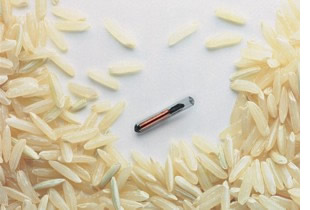
Colombia does not require that your pet be identified with a pet microchip, but it is strongly recommended that you microchip your pet with a 15 digit ISO 11784 compliant pet microchip .
The microchip should be implanted by your veterinarian, veterinary hospital or trained nurse. You should receive documentation as to the manufacturer of the microchip and instructions how to register your pet's information in the manufacturer database.

Vaccinations

To enter Colombia, your cat or dog must be vaccinated for rabies more than 21 days prior to travel and before the vaccination expires.
Cats should be vaccinated against Feline Panleukopenia, Feline Rhinotracheitis and Calicivirus. Dogs must be vaccinated against Distemper, Hepatitis, Leptospirosis and Parvovirus. Vaccination against leptospirosis is recommended but not required. If entering from a country outside the Andean Community, you pet should also be vaccinated against Parainfluenza and Coronavirus.
Pet dogs and cats whose rabies vaccination was not administered in the origination country must comply with home quarantine during which time a rabies vaccination will be administered by a licensed private veterinarian.

Rabies Titer Test

A blood titer test is not required to enter Colombia from any country.
Ticks and Tapeworm Treatment
Before your dog or cat can enter Colombia, it must have an internal and external parasite treatment. Actually, it is highly recommended that your pet be on a flea and tick prevention program prior to entering Colombia.
Pet Health Certificate
Within 10 days of travel, a licensed veterinarian in the origination country must then complete a veterinary pet health certificate (original and a copy). The certificate must be endorsed by a government veterinarian representing the agency in the origination country that is responsible for the import and export of live animals. The rabies certificate should accompany the health certificate for endorsement.
Entering Colombia by Air

Pets can enter the country at El Dorado International Airport in Bogota or the José María Córdova International Airport in Medellin during normal business hours. Pets can arrive in the cabin, checked baggage or air cargo. Those pets entering Colombia as accompanied checked baggage or air cargo must register with Instituto Colombiano Agropecuario (ICA).
When landing, you will collect your pet and head to ICA office in the airport where they will examine your pet and its documentation (which should be originals). There is a small fee for this service.
All domestic dogs and cats must be free of evidence of disease communicable to humans when examined at the port of entry. If your pet is not in apparent good health, further examination by a licensed veterinarian may be required at the owner's expense.
Puppies and Kittens

Puppies and kittens over 4 months of age entering Colombia are subject to rabies vaccination requirements per step #2. There are no vaccination requirements for puppies or kittens under 4 months of age. Home quarantine will be required in this case.
- Traveling with a puppy
Banned Breeds

Imports of specimens of canine breeds Staffordshire Terrier, American Staffordshire Terrier, Pit Bull Terrier, American Pit Bull Terrier, Mastiff, Rottweiler or any crosses or hybrids of these breeds are not permitted to enter Colombia.
Exporting Pets Living in Colombia
Other animals.

All other animals will also require an Import Permit to enter Colombia. Birds will be subject to 21 days of home quarantine. Invertebrates, tropical fish, reptiles, amphibia, mammals such as rodents and rabbits are not subject to requirements of rabies vaccination, but may have to meet other requirements and should have a health certificate to enter Colombia. Pet owners are strongly advised to seek further information from the relevant authority of their country and/or that of the country of destination.

If your pet is not a dog, cat or ferret, and especially if it is a turtle or parrot, you should verify that it is not protected under the Convention on International Trade in Endangered Species of Wild Fauna and Flora (CITES). You will need to apply for additional permits if this is the case. Over 180 countries participate and enforce CITES regulations. .
- Search CITES database .
- Read More about CITES
Need More Assistance?

To the best of our ability, we ensure that recommendations given on PetTravel.com reflect the current regulations. We cannot predict how a given country may enforce these regulations. Noncompliance may result in the need to make arrangements to put your pet into quarantine at your expense, return your pet to the country of origin, or euthanize your pet. We suggest that you minimize the disruptions that may occur by following the rules of the country you are visiting.
Further detail on import permits, costs, tests and procedures are available at minimal cost at PetTravelStore.com . We also stock all the equipment and accessories you will need for traveling with your pet. Same day shipping Monday through Friday until 2:00 PM EST.
HAVE QUESTIONS OR COMMENTS???
Due to the high demand, we may be unable to respond to your question quickly if posted below. If you need a fast response, you can post them directly to our Facebook page , blog , or forum . We will respond as soon as we can.
Please note that the accuracy of comments made from Facebook users other than Pet Travel have not been verified. We do not endorse any person or company that may offer transport services through posts to this webpage.

A Simple Guide To Traveling With Pets In Colombia
Bogotá is such a dog-friendly city that I honestly see more people with dogs than kids walking around (especially at Parque El Virrey on a Sunday). I love being able to take my dog, Riley, out to eat with me. Most cafés have outdoor seating where you can bring your dog… A few places don’t mind if you bring them inside. I’m literally writing this article right now with Riley next to me at a coffee shop. Some of the shopping malls like Hacienda Santa Barbara and Atlantis Plaza even allow you to bring your dog shopping. You’re also allowed to bring your dog on public transportation in Bogotá.
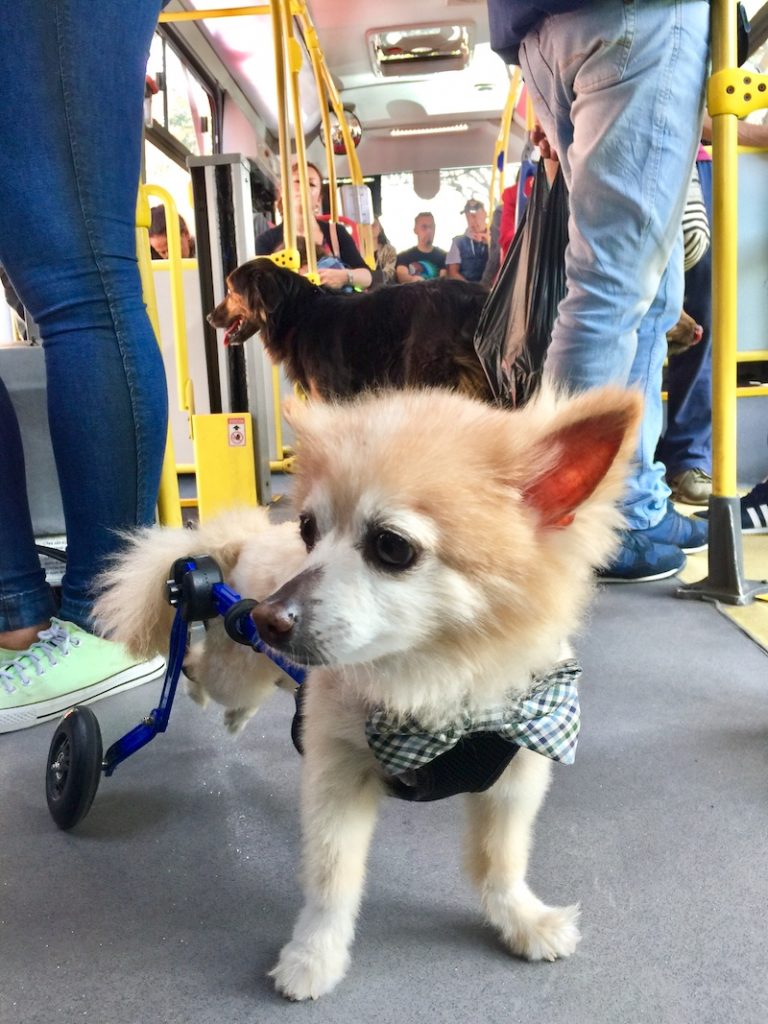
My dog Riley is paralyzed in his back legs so I need to take him with me when I travel since he requires special care. He has now traveled to five countries (United States, Panama, Costa Rica, Colombia, and Peru) and taking him in and out of Colombia is an easy and straightforward process. Here’s a quick guide I’ve written up on how to travel with your furry friend in Colombia.
Taking your pet on the plane
You do need to pay for your pet to be on the plane or get them approved as an emotional support animal once and it’s free. If your dog or cat is small, it is permitted to go in a dog carrier under the seat. If you have a large dog, it will need to be checked as cargo or get your dog approved as an emotional support animal to allow it in the cabin. Each airline has a different fee, and you typically have to pay this at the airport before your flight but some let you reserve and pay in advance. The main thing is to make sure the airline is aware that you’re bringing a dog or cat beforehand because they only allow a certain amount of animals on each flight. If you’re traveling on a national flight (Bogotá to Cartagena for example) just bring the current vaccination certificate and you’ll be fine.
Bringing your pet to Colombia

What you need:
- International Health Certificate from a veterinarian, this can be done 10 days or less before your trip.
- If coming from the U.S. this must be endorsed by the USDA. If coming from another country, you need an export form for the animal in addition to this.
- Vaccine certificate showing your dog or cat has been vaccinated for rabies. Make sure this isn’t expired.
- Make TWO COPIES of everything because you never know when you’re going to need them.
Ten days before your trip, you’ll want to visit your vet and request an international health certificate (known as APHIS Form 7001 in the States). You then have to take this form to the USDA office in your State for them to endorse it, which costs US$38.
This is where I had a scare the last time I brought my dog in because instead of going to the office directly, I mailed it, and it didn’t get back in time. In the end, I was saved because Colombia is one of the few countries that will accept an electronically endorsed certificate .
This is a new feature that most vets don’t actually know about yet (I called over 10 offices to see if they had this set up). Luckily my vet in Kentucky was super helpful and took the time to set up an account to send the certificate electronically to the USDA, and it was sent back within minutes.
If you’re traveling from another country you need an international health certificate and then you need an export form for the animal. E ach co untry has a different process for obtaining this so be sure to check these details.
Once you have your health form endorsed, this, your original vaccines certificate, and an export form (if traveling somewhere other than the U.S.) are all you need to enter Colombia. After passing through immigration, you’ll be directed to the ICA office to verify paperwork and pay a 45,813-peso (US$15) fee.
Also, if the breed of dog is a Staffordshire terrier, American Staffordshire terrier, Pit Bull Terrier, or American Pit Bull Terrier, Colombia does not allow these breeds to be imported. The way around this is to ask your vet to change to breed of the dog to something else that looks similar on the health certificate.
If you happen to mess anything up or are not able to get all of your documents together, your pet will most likely still be allowed to enter Colombia. However, you will have to pay a fine of approximately 500,000 Colombian pesos and ICA will visit you twice during a two-week period.
Taking Your Pet Out Of Colombia
Traveling with your pet when you need to leave Colombia is also a straightforward process. You first need to check and see what is required to enter the country you are visiting. If you’re going to the U.S. you don’t really need to do much! Out of all the countries I have traveled to, the U.S. has the most relaxed requirements for bringing a dog or cat. All you need to show is that your dog has been vaccinated for rabies when you enter customs in the U.S. and you’re all clear. You may also want to get an International Health Certificate from a local veterinarian 3 days before your trip to be extra safe since sometimes the airlines ask to see this. An export form is not needed.
Traveling to other countries, especially Latin American ones, seem to require the same documents. But always double check!
- International Health Certificate, no more than 3 days old
- Rabies vaccination
- Official export form from ICA
First, visit a local veterinarian in Bogotá or any city in Colombia to obtain an International Health Certificate. It’s best to do this three days before your trip (I’ve even done it on the day of a trip once). Be sure to bring the rabies certificate and the vet will also check to see if anything else is required for the country you are traveling to. I bring my dog to Animal Center in Rosales if you need a vet suggestion.
Next, make two copies of the health certificate and your rabies certificate. You just never know when you are going to be asked for an extra copy of something so it’s better to have these on hand.
Finally, on the day of your flight, you can visit the ICA office at the Bogotá airport to get the export form . This is located as far right as you can go on the arrivals level, a bit outside of the airport. Just ask an official if you have trouble finding it and they will point you in the right direction. You should arrive 4 hours before your flight because they take forever to process each certificate and you never know how long you will have to wait. Also, the office is only open on WEEKDAYS from 7 am – 5 pm and CLOSED ON LOCAL HOLIDAYS. If you’re traveling on a weekend or local holiday you need to get your export form the day or two before. The form has a cost of $47,311 Colombian pesos and this is payable with credit card. If you are traveling from one of the other international airports in Colombia you should verify the location and operating hours.
Experience Bogotá

I'm Joey, a guy from Louisville, Kentucky that packed up and studied abroad at the age of 20 and hasn't moved back since. What started as a semester trip to Panamá has turned into 10+ years of living in Latin America and becoming a full-time travel blogger where I now mostly reside in Bogotá, Colombia. Follow me on Instagram at @joeybonura for more updates on my life abroad!

How To Use Bogotá’s TransMilenio Bus System

Treehouse Getaway – Only 1.5 Hours From Bogotá
Related posts.

Unveiling Bogotá’s Best Vegan Eateries

A Queer Guide To Bogotá, Colombia

32 Things You MUST DO In Bogotá, Colombia

A Quick Guide To Medellín, Colombia
Descubra el pulso de medellín, colombia.

Explore The Best Hot Springs Near Bogotá

Explore las mejores aguas termales cerca de Bogotá


Playing Tejo In Bogotá: An Explosively Good Time

Villa de Leyva: A Charming Getaway From Bogotá

Encanto de La Luna: A Colorful Colombian Home With Hot Springs

Encanto de La Luna: Casa con aguas termales privados

Homes With Gorgeous Swimming Pools Close To Bogotá
Comments are closed.


Colombia Pet Transport: A Comprehensive Guide for Importing Dogs and Cats
What to know about bringing dogs and cats to colombia, colombia pet import rules and requirements.
When planning pet transport to Colombia, it's important to start early and familiarize yourself with the requirements to avoid misunderstandings or delays in the import process.
If you're transporting a dog to Colombia, take note of the country's list of banned breeds. Colombia prohibits the entry of certain breeds, including Pit Bull Terriers, Rottweilers, Doberman Pinschers, and a few other large breeds, along with mixed-breed dogs containing any of these breeds. Read on for more information.
Selecting a pet-friendly airline, acclimating your pets to their travel kennels well in advance, and consulting your veterinarian for health-related concerns are essential steps to ensure a smooth move.
With the right preparation and planning, bringing pets to Colombia can be carried out safely. Let's explore the regulations and procedures for importing pets to Colombia.
Request Support
Regulations for Importing Pets to Colombia
Attention: This information will be used as general guidelines and may not be updated to meet the current requirements. Before you travel, be sure to contact the appropriate authorities in Columbia.
Important Information Regarding Banned Dog Breeds
Colombia does not permit the following dog breeds to enter the country, including purebreds and mixed breeds containing any of the following:
- American Staffordshire Terrier
- Pit Bull Terrier
- American Pit Bull Terrier
- Japanese Tosa
- Doberman Pinscher
- Bullmastiff
- Mastin Napolitano
- De Presa Canario
- Dogo Argentino
- Dogo de Burdeos
- Fila Brasileiro
Although not mandatory for entry into Colombia, we highly recommend microchipping all traveling pets for identification purposes.
Rabies Vaccination and Certificate
All pets must have an original Rabies Certificate, which must state the microchip number (if applicable) and the date of inoculation.
Vet Health Certificate (Form 7001)
The standard Health Certificate, completed by a USDA-accredited veterinarian, must be issued within ten days of the flight.
USDA Endorsements
The following documents must be sent to your local USDA (if departing from the United States) for endorsement:
- Microchip Implantation Record (if applicable)
- Rabies Certificate
- Vet Health Certificate
Recommended Vaccines
We strongly recommend the following vaccinations for your pets:
- Dogs: Distemper, Hepatitis, Leptospirosis, Parainfluenza and Parvovirus (DHLPP), and Bordetella.
- Cats: Feline Viral Rhinotracheitis, Calicivirus, and Panleukopenia (FVRCP).
These vaccinations should be valid at the time of import and administered no less than two weeks before the export date for maximum effectiveness.
Additional Details
All original documents listed above must accompany the pets during travel. For successful customs clearance, we require a copy of the pet owner's passport before the animal's arrival.
Our team at PetRelocation is dedicated to providing a safe and comfortable travel experience for your pets. Contact our PetRelocation Specialist to discuss your options and receive expert support.
Pet Travel Stories
“I was very afraid of the idea of moving Tazy and having her go through such a long journey, But Evelyn and Kelcey practically held my hand the entire time.”
Tazy’s Move: Bringing Dogs to Argentina
From our blog.
Understanding Pet Transport Safety: Myths, Facts, and Recommendations | PetRelocation
Pet Travel Question: Can Pit Bulls go to Ecuador?
Pet Travel Question: Moving Pets from Brazil to the US
Pet Move Customer Story: Senior Boxers Move to Brazil
Pet Move Customer Testimonial: Scarlet and Dyna’s Move to the United States
Pet Move Customer Testimonial: Abu Junior’s Move to the US
Customer Testimonial: Logan, Maya and Niko’s Dog Move to the United States
Moving Pets to Costa Rica - Buta and Luna’s Move!
- Mon-Fri : 8am-7pm
- Sat & Sun Closed
USDA Pet Health Certificates
We are the experts in preparing the necessary paperwork for pet travel across the globe.
USDA Pet Health Certificates for International & Domestic Travel
University Animal Hospital continues to excel as the best, and most highly recommended, provider of USDA Pet Health Certificates in New York City for both International and Domestic Travel.
Every country has very specific and unique health requirements.
Improper or incomplete travel paperwork can derail your travel plans, costing you valuable time, money and aggravation.
DIGITAL SUBMISSION (VEHCS) - We are proud to have been selected by the USDA to access their Digital Submission and Endorsement Platform (VEHCS) enabling us to expedite your pet’s international travel certification. Many countries now allow our veterinarians to electronically submit your pet’s certificates and supporting documentation to APHIS for review and USDA endorsement.
Our team of USDA-certified veterinarians have successfully helped pet owners prepare for travel domestically and abroad for many years. We will walk you through the process from start to finish. Our experienced team will ensure the accuracy of your documentation for your pet’s travel.
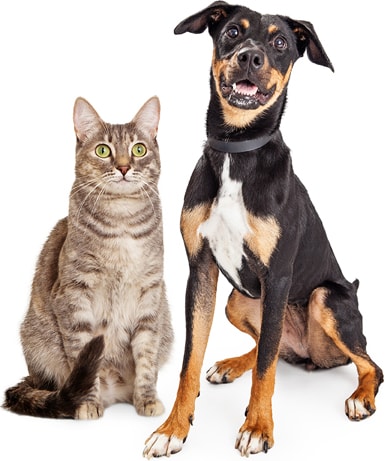
Domestic Travel Certificates
A Certificate of Veterinary Inspection, otherwise known as a health certificate , certifies that your pet is healthy, free from all contagious diseases, and able to travel within certain climates.

International Travel Certificates
Only our USDA Accredited Veterinarians have the authority to both examine your pet and issue the USDA required paperwork for traveling internationally. As the requirements vary from country to country we strongly recommend you allow our experienced team to secure all of your necessary documentation .

About University Animal Hospital

University Animal Hospital is a full-service medical, surgical and dental clinic for dogs and cats, located in Manhattan .
The goal of our animal hospital is to provide superior veterinary care while showing compassion for pet patients and their owners. We treat our clients’ pets as if they were our own.
University Animal Hospital is staffed by a team of knowledgeable, dedicated and compassionate professionals working to provide the highest level of veterinary care .
Under the leadership of Dr. Lawrence Zola , the staff at University Animal Hospital has consistently demonstrated compassionate, loving and affordable medical care for more than a quarter of a century.
Our Location
(212) 288-8884
MANHATTAN 354 East 66th Street New York, NY 10065 Located between 1st and 2nd Avenues
Monday-Friday: 8AM-7PM Saturday-Sunday: Closed
Resources and Services by University Animal Hospital:
Hover over any section (or tap on mobile) to see more information

PET DENTAL CARE
Caring for your dog or cat’s oral health can make a significant difference in their quality of life, especially as he or she gets older. University Animal Hospital provides dental examinations, cleanings and advanced veterinary dental technology.

NEW RULES FOR SERVICE DOG/ COMFORT ANIMALS ON AIRLINES:
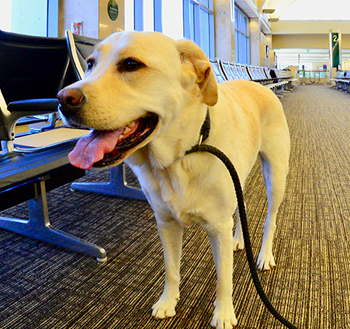
PREPARING FOR TRAVEL WITH YOUR PET:
See us on instagram.

Get Started on Your Certificate
US-made, Eco-friendly Products for Larger Dogs . We Donate 5% of Sales to Dog Rescues . Free US Shipping over $50 .
All Categories
- Collars & Harnesses
- Accessories
- Grooming & Health
- For the Folks
- Friend of the Month
- Our Rescue Partners
- In the News
- Frequently Asked Questions
- Shipping & Returns
- Privacy Policy
- Collars & Harnesses
- Grooming & Health
Bringing your dog into South America
Are you in the beginning stages of planning a move to South America? Or, are you planning on taking an extended trip there? I have recently been seeing many people who are choosing the expat life, many more who are deciding to take months-long vacations to South America, and I have also seen a substantial number of people choosing to retire there. If any of these describe you and your plans for South America travel, you may be curious and ready to learn what the rules and regulations are when it comes to bringing your dog into South America .
As a pet owner, moving is hard. This is true no matter where you are moving. Moving to a new city or a new state when you have a pet means that you have more work cut out for you. Moving to a new country or continent means that the work is amplified tremendously. When you have pets that you love though, this is well worth it.
When you are planning a move, it is imperative to know the steps that you need to take before you depart on your new journey. One thing that I do know is that moving to a new country with a pet can be a process, so I am happy that you are looking this up now, before you are down to the wire. You are saving yourself a lot of stress and unnecessary complications by being ready in advance.
If you are ready to start your new journey with your canine kids, here are the steps you need to take before bringing a dog into South America.
Should you bring your dog into South America?
Okay, I feel that it would be irresponsible of me to not to at least bring up that many people recommend not bringing a pet with you to South America. The following concerns are some of the reasons why people make this recommendation:
- Countries in South America often have higher incidence of rabies, tick-borne diseases, distemper, as well as tropical diseases. Yes, I know that you will certainly have your dog up to date on all of their shots and vaccinations, but there are no guarantees.
- Your lodging may not allow it. Many hostels, hotels, and rental homes don’t allow dogs.
- Finally, there are countless close-to-feral dogs on the streets in South America. These dogs tend to leave humans alone, but many of these dogs aren’t too friendly with other animals. If your plans don’t include many walks along the streets and neighborhoods, this likely won’t be a problem, but it is definitely something to consider. Dog fights are not an uncommon occurrence on the streets of South America.
The most important things to do before bringing your dog to South America
Now that we have gotten some of the risks and “why nots” out of the way, let’s talk about the most important things for you to do once you reach the decision to bring your dog with you on your travels to South America.
Make reservations for your dog
As soon as you make the decision to take your dog to South America with you, be sure to call the airline and make reservations for your dog. This is required whether you are planning to send your dog in the luggage area or if they will be in the cabin with you. Airlines have a limited number of animals that they allow on each flight so you want to be sure that your dog gets one of those spots.
Make sure that your dog is in good health
This is true for any country you plan to visit or move to, but it is imperative that you first make sure that your dog is in good health. To confirm their good health status, you need to take your dog to a licensed veterinarian for a full check up. For most countries, this checkup needs to be done within 10 days of your departure.
Be prepared with the proper documentation and requirements for your destination
Send an International Health Certificate to your closest veterinarian services office to be endorsed. You will probably need to make sure you have a Spanish version as well. Having this form filled out and on hand will make your travel and arrival much easier. Additionally, while not required everywhere, it’s good to have a copy of veterinarian/health records on hand (and translated into Spanish) as well in case any questions should arise.
Make sure your dog is up to date on their rabies shot
This kind of goes along with your dog being in good health, however, I think it deserves it’s own mention. It is imperative to be sure that your dog is up to date on their rabies vaccination. Different countries have different risks of rabies and it’s best to be proactive with your own pet.
Know the rules for your method of travel
How are you planning to get to there? Will you be visiting other countries in South America? Many countries have different requirements for bringing a dog across (and back across) the borders depending on your mode of transportation.
Give your pup a bath
It’s always a good idea to give your dog a bath before and after your trip. A freshly washed dog is less likely to bring attention and very few countries will allow your dog to enter with excess dirt or debris in their fur.
Get your dog microchipped
It is recommended that you microchip your dog and register your contact information prior to traveling as a means of identification should your dog get separated from you.
What websites should you check before bringing your dog into South America?
It’s imperative to continually monitor the requirements of your destination country on the APHIS (Animal and Plant Health Inspection Service) website. This is the best resource to keep track of any current, new, or changing requirements for bringing your dog with you into any of the countries in South America. It’s good to visit the main website initially for any overall rules that may come up from your current location. However, the following links will take you to the specific requirements for pet travel for your destination within South America.
Please note that this information is specific to travel to South America from the United States. In general, the requirements should be similar for other countries of origin, or at least a good starting point.
You will not need to quarantine your dog. You must vaccinate your dog for rabies not less than 21 days and not more than 36 months prior to arrival. If your dog is originating from a country that is considered as rabies free by the Organization of Animal Health, vaccination is not necessary to enter; however, you will need to get the vaccination within five days of entry.
You do not need an import permit to bring your dog into Argentina. However, within 10 days of arrival, you must get a Veterinary Health Certificate (in both English and in Spanish). The certificate must be endorsed by your State USDA office if your pet is traveling from the United States or by your local CFIA office if your pet is traveling from Canada. If you are traveling from another country, you will only need an endorsement if your country mandates it. You will need to present the original health certificate to veterinary officials when custom clearing your pet.
Argentina will accept EU pet passports from EU countries, Switzerland, and Norway. The passport should be in Spanish or a national public translator will be assigned at customs clearance.
You must treat your dog against internal and external parasites within 15 days of arrival.
Pets can enter the Argentina via Ministro Pistarini International Airport in Buenos Aires. All domestic dogs must be disease free when examined at the entry airport. Your airline must notify the station manager at the point of entry, at least 24 hours prior to arrival, giving notice of pets on board in order to ensure the attendance of the veterinary surgeon at the arrival airport. You may have to pay a customs fee.
Puppies under the age of three months can enter without a rabies vaccination certificate. They must have a health certificate and the issuing veterinarian must state that the puppy originates from an area where rabies has not occurred in the past 90 days.
You must obtain a health certificate issued by an accredited veterinarian within 3 months of arrival. The certificate must include the complete identification of the animal, including breed, sex, and age; owner’s name and address; address at destination; and date of rabies vaccination. The certificate needs to be endorsed by veterinary services and must be legalized at a Bolivian Consulate for a fee.
You must obtain a health certificate issued by an accredited veterinarian before bringing your dog into Brazil. The health certificate is valid for 60 days from the day of issues and it must be valid at the time of arrival.
You must obtain a health certificate issued by an accredited veterinarian and endorsed by USDA-APHIS before bringing your dog into Chile. Upon arrival, your dog may have to be quarantined for at least 30 days.
You must obtain a health certificate issued by an accredited veterinarian and endorsed by USDA APHIS Veterinary Services within 10 days of travelling to Colombia. You will also need to bring a rabies vaccination certificate. Your pet must travel with at least one photocopy of the original health certificate.
You must obtain a health certificate issued by an accredited veterinarian within 10 days of going to Ecuador. It must state that your is healthy with no symptoms of infectious diseases and without visible external parasites (mites, ticks, fleas) also should include race, sex, color, and age of your dog. The health certificate will need to be typed and in Spanish.
Your dog needs to get their vaccinations at least 21 days prior to arrival. You will need to show proof of vaccinations of the following diseases: distemper, canine hepatitis, leptospirosis, parvovirus, parainfluenza, and rabies (for dogs older than 3 months). The vaccination certificate should include the date of immunization, type, and brand of the product used.
If you bring your dog on the airplane with you, you will be able to pick up your dog in the international arrival area. You will need to present the Animal Health Export Certificate issued by an accredited veterinarian of the country of origin. You will need to contact the Ecuadorian Agency of Quality Assurance in Agriculture “AGROCALIDAD” staff working in the port of entry, 72 hours in advance of your arrival time. This is so that they can carry out a clinical inspection of your dog.
French Guiana
An APHIS-endorsed international health certificate is not a requirement. However, dogs must have a valid rabies vaccination certificate from a licensed veterinarian. The rabies vaccination must be given either within 30 days of travel for dogs that did not have a lapse in their rabies vaccine coverage; more than 30 days before travel for dogs that had a lapse between rabies booster vaccinations; or more than 30 days before travel for dogs vaccinated for the first time prior to travel.
You can only bring a maximum of three pets with you. Of the three animals, only one can be a puppy or kitten under 6 months of age.
No specific requirements are on the APHIS website. You will, however, need to get a health certificate from an accredited veterinarian. The certificate must include the complete identification of the animal, including breed, sex, and age; owner’s name and address; address at destination; and date of rabies vaccination. Contact the consulate for specific instructions to be absolutely clear as to what you will need to provide.
You must obtain an international health certificate issued by an accredited veterinarian within 30 days of arrival. The certificate must include the complete identification of the animal, including breed, sex, and age; owner’s name and address; address at destination; and date of rabies vaccination. You will need to get this certificate from a USDA-approved federal veterinarian.
No specific requirements are on the APHIS website. You will, however, need to get a health certificate from an accredited veterinarian. The certificate must include the complete identification of the animal, including breed, sex, and age; owner’s name and address; address at destination; and date and type of rabies vaccination. Contact the consulate for specific instructions to be absolutely clear as to what you will need to provide.
You must get an APHIS-endorsed health certificate from a USDA-accredited veterinarian within 10 days of arrival.
A rabies vaccination certificate is a must. For dogs over three months of age, this vaccine has to given at least 30 days before arrival.
You have to show that your dog is negative for Leishmania. Within 15 days prior to obtaining the health certificate, your dog has to take a broad spectrum parasitic. You must treat your dog for Echinococcus granulosus at least 72 hours and no more than 30 days prior to arrival.
You must get a health certificate from a USDA-accredited veterinarian within two weeks of arrival. Your dog must show proof of vaccination for rabies, unless they are a dog is under four months old. Your dog also has to so proof of vaccination against distemper, hepatitis, leptospirosis, parvovirus, and parainfluenza.
Budget extra money
Here’s the thing. In other countries, things happen, rules and regulations change and you just simply never know what might happen. For this reason I recommend budgeting extra money for anything that may come up. Just like with everything else, it’s always good to prepare for all emergencies.
Hope this helps makes planning for bringing your dog into South America a little easier. Have fun and safe travels with your pup. And if you are driving around in the car, have a read of our tips on taking a road trip with your dog .
Here’s a handy downloadable bringing your dog to South America checklist:
Share This Post
Related posts, how technology is transforming our relationship with our dogs, furry fun: 10 interesting facts about dogs, alternatives to dog parks: why they may not be ideal and what dog parents can consider.
ABOUT US USA-made, eco-friendly dog products that give back.
980-285-7897
USEFUL LINKS Home Blog About Us Contact Us Friend of the Month Rescue Partners
HELP Shop Checkout My Account Cart
Official websites use .gov
A .gov website belongs to an official government organization in the United States.
Secure .gov websites use HTTPS
A lock ( ) or https:// means you've safely connected to the .gov website. Share sensitive information only on official, secure websites.
From August 1, 2024, Onward: What Your Dog Needs to Enter the United States
At a glance.
Starting on August 1, 2024, dogs entering or returning to the United States must meet new, specific requirements depending on where they have been in the 6 months before entering the U.S. and where they received their rabies vaccines (if required).
Requirements for all dogs
Requirements for dogs with a current and valid rabies vaccination administered in the united states.
- Requirements for foreign-vaccinated dogs that have been in a country with high risk of dog rabies within 6 months before entry
Requirements for dogs that have been ONLY in countries that are dog rabies-free or low-risk during the 6 months before entry
All dogs must:
- Be at least 6 months of age at time of entry or return to the United States
- This must have been implanted prior to any required rabies vaccination
- The microchip number must be documented on all required forms and in all accompanying veterinary records
- Dogs may not enter the United States if they are carrying a disease contagious to people.
- Isolation of the dog, veterinary examination, and additional testing, at the importer’s expense, may be required to determine if the dog has a contagious disease and prevent spread if the dog does not appear healthy upon arrival.

This form should be filled out online ideally 2-10 days before arrival; however, it can also be completed right before travel (even in line at the border crossing) if you have internet access. If the information on the form changes before the dog arrives, you must submit a new form and indicate you are making changes to an existing form. All information, including port of entry where the dog is arriving, must be correct at time of arrival.
- This form requires you to upload a clear photograph of the dog showing its face and body. Dogs that will be less than one year of age at time of arrival should have the photograph taken within 10 days before arrival.
- There is no charge to importers for submitting this form.
- Additional requirements for dogs with a current rabies vaccination administered in the United States
- Additional requirements for dogs that have been in a country at high-risk for dog rabies within the 6 months before entry and do NOT have appropriate documentation of current US-issued rabies vaccine
- Additional requirements for dogs that have been ONLY in countries that are dog rabies-free or low-risk in the 6 months before entry
Dogs that do not meet all entry requirements or do not have accurate and valid forms will be denied entry to the United States and returned to the country of departure at the importer’s expense. These requirements apply to all dogs, including service dogs and dogs that were born in the United States.
Specific requirements depend on whether the dog has been in a high-risk country for dog rabies in the past 6 months.
Dogs with a current rabies vaccination administered in the United States that have been in a high-risk country for dog rabies must:
- Meet all requirements in the “All Dogs” section above
- The Certification of U.S.-issued Rabies Vaccination form is required for the importation (re-entry) of U.S.-vaccinated dogs that have been in high-risk countries for dog rabies within the 6 months before re-entry into the United States.
- Please note, during the transition period (which will expire on July 31, 2025), the importer may instead present a copy of the USDA-endorsed export health certificate that was used to ship the dog from the United States, if that export health certificate was issued by a USDA-accredited veterinarian before July 31, 2025, and documents the dog’s age (at least 6 months), the microchip number, and valid rabies vaccination administered in the United States. The rabies vaccination must be valid (not expired) on the date of return or the form will be invalid.
- This can be any airport, land border crossing, or sea port but you must select this location when you complete the CDC Dog Import Form.
Dogs with a current rabies vaccination administered in the United States that have NOT been in a high-risk country in the last 6 months must:
- A Certification of U.S.-Issued Rabies Vaccine form that was endorsed by USDA before the dog departed the United States; or
- Be for the dog rabies-free or low-risk country where the dog’s return itinerary originated (the form will only be valid for 30 days if it does not contain rabies vaccination information), or
- Document a valid (unexpired) rabies vaccination administered in the United States (the form will be valid for the duration of the rabies vaccination (1 or 3 years)).
- (This can be any airport, land border crossing, or sea port but you must select this location when you complete the CDC Dog Import Form .)
Important information about the Certification of U.S.-Issued Rabies Vaccination Form
The Certification of U.S.-Issued Rabies Vaccination form must be completed before the dog departs the U.S. Before asking your veterinarian to complete this form, verify the following requirements will be met:
- Ensure your dog will be at least 6 months of age on date of return to the U.S.
- Have your dog microchipped with an International Organization for Standardization (ISO)-compatible microchip (implanted before any required rabies vaccinations)
- Ensure the veterinarian scans the dog for the ISO-compatible microchip and records the microchip number at the time of vaccine appointment. Rabies vaccines administered prior to microchip implantation will not be considered valid.
- Ensure the rabies vaccination will be valid for the entire duration of your travels. If your dog’s U.S.-issued rabies vaccination lapses while overseas and your dog has been in a high-risk country in the past 6 months, your dog will need to be revaccinated overseas and meet requirements for foreign-vaccinated dogs to return to the U.S., including having a rabies serology titer, arriving at a specific port of entry, and possible quarantine requirements.
- Your dog must receive its initial (first) rabies vaccine at least 28 days before leaving the United States. USDA-accredited veterinarians should only issue the Certification of U.S.-issued Rabies Vaccination form for dogs that received their initial (first) rabies vaccine at least 28-days previously. Booster vaccines are considered valid immediately.
- Ensure the veterinarian submits this form to the USDA for official endorsement through the VEHCS portal
- Your dog must travel with a printed copy of the official endorsed form upon your dog’s return to the United States if your dog has been in a high-risk country within the 6 months before returning to the U.S.
During the transition period (which will expire on July 31, 2025), U.S.-vaccinated dogs that have been in a high-risk country in the past 6 months, may have either the Certification of U.S.-Issued Rabies Vaccination form or the USDA endorsed export health certificate for re-entry into the United States. Without one of these forms your dog will need to meet the requirements specific to the risk category of the countries where they have been in the 6 months before returning to the United States.
The export health certificate must be issued by a USDA-accredited veterinarian before July 31, 2025, and document the dog’s age (at least 6 months), microchip number, and the rabies vaccination date. The rabies vaccine must be valid (not expired) on the date of return or the form will be invalid.
Requirements for foreign-vaccinated dogs that have been in a country with high risk of dog rabies within 6 months before entry
Dogs, including service dogs, that have been in a country at high-risk for dog rabies within the 6 months before entry and do not have appropriate documentation of current U.S.-issued rabies vaccine must:
- Meet all requirements in the “All Dogs” section
- Ensure the dog is microchipped with an International Organization for Standardization (ISO)-compatible microchip before receiving the rabies vaccination and the number is recorded on the veterinary documents or the vaccine will not be considered valid
- Verify the dog is at least 12 weeks (84 days) of age when vaccinated against rabies
- The dog must have a valid (i.e., non-expired) rabies vaccination. If it’s the dog’s first vaccination or if the dog’s vaccination coverage has lapsed, the vaccine must be administered at least 28 days before arrival to the United States.
- The Certification of Foreign Rabies Vaccination and Microchip form must be completed by your veterinarian AND endorsed by an official veterinarian in the exporting country.
- The blood sample for the rabies serology titer must have been drawn at least 30 days after the dog’s first valid rabies vaccination and at least 28 days before entry to the U.S.
- Dogs with a history of multiple valid rabies vaccinations administered after the microchip was placed may have the sample for the rabies serology titer drawn at any time after a rabies booster vaccination as long as the dog’s first vaccine was given at least 30 days before the blood sample was drawn and there has been no lapse in vaccine coverage. If a lapse occurs, the sample must be drawn at least 30 days after the valid booster vaccination was administered.
- The sample must be sent to a CDC-approved rabies serology laboratory . If there is no CDC-approved laboratory in your country, your veterinarian may draw the sample and send it internationally to a CDC-approved laboratory.
- Passing results must be obtained in order for a serology to be valid.
- Rabies serology titer results will be considered valid for the life of the dog as long as the dog’s rabies vaccination coverage does not lapse. If a lapse occurs, a new rabies serology titer will be required and that sample must be drawn at least 30 days after the new vaccination was administered.
- If the dog does not have a valid rabies serology titer, it will be required to be quarantined at a CDC-registered animal care facility for 28 days after the dog is revaccinated by the facility’s veterinarian.
- All foreign-vaccinated dogs that have been in a high-risk country in the previous 6 months must have a reservation for examination, verification of age, documents, and microchip number, and administration of a rabies booster vaccination at a CDC-registered animal care facility immediately upon arrival in the United States.
- Dogs that do not have a valid rabies serology titer must also have a reservation for quarantine. Dogs will be quarantined at the facility for 28 days at the importer’s expense after being revaccinated by the facility’s veterinarian.
- All CDC-registered animal care facility expenses, including exam, revaccination, and quarantine (if required), are the responsibility of the importer.
- The facility will need copies of all required documents prior to confirming your reservation.
- Ensure the dog meets any facility-specific requirements (contact facility for additional information).
- If after arrival the CDC-registered animal care facility determines that your documents are not valid or the dog’s microchip number, age, or description does not match the paperwork provided, the dog may be denied entry and returned to the country of departure at your expense.
- Dogs that have evidence of illness or are not healthy will be required to have testing to confirm they do not have contagious diseases before they will be eligible for release, which may extend the required quarantine period beyond 28 days. Any required testing or extended stay in quarantine will be at the importer’s expense, so please ensure dogs are healthy upon arrival (including no evidence of fleas, ticks, or skin diseases).
- Dogs must arrive to the U.S. at the airport where the CDC-registered animal care facility is located. This must be the location where the dog has a reservation.
- This must also be the airport listed on the CDC Dog Import Form
- Domestic flights or other forms of travel to other locations in the U.S. are not permitted until after the dog receives required follow-up services at the CDC-registered animal care facility and is cleared for entry.
- SERVICE DOGS ARRIVING BY SEA : Service dogs, as defined in 14 CFR 382.3, may arrive by sea if they meet the requirements in the “All Dogs” section, have a complete Certification of Foreign Rabies Vaccination and Microchip form and a valid rabies serology titer, and are traveling with their handler. Emotional support animals are not service animals under this definition.
Countries that are not on the list of countries at high risk for dog rabies are considered to be free of or low risk for dog-mediated rabies virus variant (DMRVV) (called dog rabies-free or low-risk countries on these webpages).
Dogs, including service dogs, that have been ONLY in dog rabies-free or low-risk countries during the 6 months before entry into the United States must:
- A single entry into the U.S. for 30 days after it was issued if it does not contain information about rabies vaccination administered in a dog rabies-free or low-risk country, OR
- Multiple entries into the U.S. for the duration the rabies vaccination is valid (1 or 3 years) if the rabies vaccination was administered in a dog rabies-free or low-risk country
- Certification of Foreign Rabies Vaccination and Microchip form, including the endorsement by an official veterinarian of the dog rabies-free or low-risk country where the dog has been located; AND EITHER (1) a valid rabies serology titer OR (2) veterinary records* (which list the microchip number) for the dog from the exporting country for the previous 6 months. The form must be completed within 30 days before arrival to the United States and is valid for a single entry.
- Certification of U.S.-Issued Rabies Vaccination form that was endorsed by USDA before the dog departed the United States
- Is for the dog rabies-free or low-risk country where the dog’s return itinerary originated (the form will only be valid for 30 days if it does not contain rabies vaccination information), or
- Documents a valid (unexpired) rabies vaccination administered in the United States (the form will be valid for the duration of the rabies vaccination (1 or 3 years)).
- Foreign export certificate that documents the dog is at least 6 months of age, lists the dog’s International Organization for Standardization (ISO)-compatible microchip number, and has been endorsed by an official veterinarian of the exporting country; AND veterinary records* (which list the microchip number) for the dog from the exporting country for the previous 6 months. The certificate must be issued within 30 days before arrival to the United States and is valid for a single entry.
- Arrive at the location listed on the CDC Dog Import Form receipt (This can be any airport, land border crossing, or sea port but you must select it when you complete the CDC Dog Import Form .)
Any documentation that is not from the United States must be completed in the country where the dog’s travel originates. For example, if the dog’s documents were issued in France, the dog may not enter the U.S. via a land-border crossing from Mexico to the U.S.
*Examples of veterinary records that must accompany completed forms are European Union pet passports or proof of payment for veterinary services received in the exporting low-risk country for the previous 6 months. Records must include the dog’s microchip number.
For more information, see: Frequently Asked Questions on CDC Dog Importations
If you have questions or need more information, please contact CDC-INFO at (800) 232-4636.
- Travelers' Health
- Healthy Pets Healthy People
- Southern Border Health and Migration
- Port Health
- Division of Global Migration Health
To receive email updates about this page, enter your email address:
Exit Notification / Disclaimer Policy
- The Centers for Disease Control and Prevention (CDC) cannot attest to the accuracy of a non-federal website.
- Linking to a non-federal website does not constitute an endorsement by CDC or any of its employees of the sponsors or the information and products presented on the website.
- You will be subject to the destination website's privacy policy when you follow the link.
- CDC is not responsible for Section 508 compliance (accessibility) on other federal or private website.

APHIS Updates Pet Travel Website With New Resources
APHIS Updates Pet Travel Website with New Resources
Many people see pets as important family members and want to include them on international trips. For dogs and cats, there's a lot more to do than just buying a plane ticket. To successfully complete the steps needed for pets to travel internationally and then return to the U.S., there are specific foreign country and U.S. requirements. The process varies by country and by type of pet, and there are specific timeframes when steps must take place.
APHIS knows the process is complex and is committed to helping our customers - human and animal - meet the requirements. With that in mind, APHIS recently made some changes to our Pet Travel website in order to make the whole process easier and less stressful. These changes will benefit travelers and their veterinarians alike.

The new Helpful References page contains general information about the international pet movement process, including the steps involved and frequently asked questions (and answers). The page also contains links to new materials in Spanish, Chinese, Korean and Portuguese that explain the steps in the process and how to use the pet travel website.
APHIS also made several changes to help accredited veterinarians through the process. Accredited veterinarians are private veterinarians who take special training and are authorized to perform specific animal health tasks for APHIS. In the case of pet travel, they are responsible for examining pets, completing necessary tests and filling out the required documentation. To help them out, APHIS added a color-coded banner on the country-specific pages that will provide information about whether digital or hard copy signatures must be used, both by the accredited veterinarian and by the APHIS endorsing veterinarian. USDA also updated the country-specific pages to add guidance documents and annotated certificates to help ensure the forms are completed correctly.
USDA launched this page a few years ago and it remains one of the most visited pages on our website. Questions about pet travel are some of the most frequent calls received by the APHIS call center (1-844-820-2234). These new resources will provide even more detail and assistance to ensure travelers can safely travel internationally with their beloved pets.
SUBSCRIBER SERVICES: Manage Preferences | Unsubscribe | Help

Aquí comienza una experiencia de
Viaje Feliz

Traslado nacional e internacional de mascotas

Viaja con tu mascota

Título Serológico

Venta de kennel autorizados por las aerolíneas

¿Necesitas realizar un trámite ante el ica?

Servicios veterinarios
Trámites con las autoridades competentes, certificado de salud internacional, desparasitación, implantación microchip, trámites consulares - apostille (panamá ), serología de anticuerpos rábicos (comunidad europea - ee.uu), testimonios.
“¡ Holaaa! ¡ Gracias por todo el viaje fue muy bieen! ❤️ Ya llegamos y ya estoy con mi familia, mil gracias”
Daniela - Colombia a España
Trasladamos con amor
Colombia a República Dominicana
“Nos fue excelente❤️💝 llegamosssss.”
María del Sol - Colombia a Canadá
Colombia a Suecia
“… Muchas gracias a ustedes por tan maravilloso trabajo, de verdad estoy muy feliz que ella esté aquí conmigo”
Karen - Colombia a Alemania
Colombia a España
“Muchas gracias muy agradecida de corazón”
Fabiola - Chile a Colombia
Colombia a Chile
“Buenos dias, muchisimas gracias nos fue muy bien”
Mayerly - Brasil a Colombia
Perú a Colombia
“Fue un momento inigualable, el reencuentro con nuestros seres queridos en España y por ello estamos infinitamente agradecidos”
Laura - Colombia a España
Estados Unidos a Colombia
Muchas gracias por hacer parte de este sueño de poder viajar con Zeus y verlo feliz corriendo por la playa y nadando en el mar😊Ver la felicidad de Zeus fue lo mejor del viaje
Johan M. - Bogotá a Cartagena
Colombia a Estados Unidos

Una persona puede viajar con más de una mascota en una cabina de avión
Lorem ipsum dolor sit amet, consectetur adipiscing elit, sed do eiusmod tempor incididunt ut...

Qué requisitos debe tener mi mascota para viajar a la Unión europea

Razas braquicéfalas en avión
Debido a las características físicas y a los problemas respiratorios que tienen las razas de...

Qué es un Microchip
El microchip es un sistema de identificación permanente para los animales de compañía el cual...

¿Un perro grande puede viajar en cabina?
contenido de la infocontenido de la infocontenido de la infocontenido de la infocontenido de la...

¿Qué es una serología?
El primer paso realizar una serología es aportar el certificado de la vacuna contra la rabia...

+57 311 808 1004
Cra 21 # 3 B-74 - Manizales, Caldas, Colombia
Síguenos en nuestras redes sociales
Cra 21 #3 B-74 - Manizales, Caldas, Colombia


IMAGES
VIDEO
COMMENTS
Colombia will reject pets that do not meet the requirements of the posted health certificate. Personal pet dogs or cats do not need an import permit. Dogs and cats must be accompanied by a health certificate issued by a USDA Accredited Veterinarian and endorsed by USDA APHIS Veterinary Services within 10 days of travel.
To enter Colombia with a pet, your cat or dog must be vaccinated for rabies more than 30 days before travel to Colombia and before the vaccination expires. Also, Colombia does honor the 3-year vaccine. Dogs reportedly must also be vaccinated against Distemper, Hepatitis, Leptospirosis and Parvovirus.
Vaccinations. To enter Colombia, your cat or dog must be vaccinated for rabies more than 21 days prior to travel and before the vaccination expires. Cats should be vaccinated against Feline Panleukopenia, Feline Rhinotracheitis and Calicivirus. Dogs must be vaccinated against Distemper, Hepatitis, Leptospirosis and Parvovirus.
Discover how to obtain and complete the APHIS Form 7001 for international pet transport. Learn about the USDA's International Health Certificate requirements, the endorsement process, and the Veterinary Export Health Certification System (VEHCS) for electronic submissions. Trust PetRelocation for expert guidance on international pet travel.
A great place to start is the Pet Travel website of the US Department of Agriculture's Animal and Plant Health Inspection Service (APHIS). Airlines. Different airlines have different rules about whether and how a pet can travel. Depending on the airline, your pet may be able to travel on your flight either in the cabin or in the cargo hold.
Once you arrive in Colombia, you will take your pet to Instituto Colombiano Agropecuario Office (ICA) inside the airport. Your pet will be examined here, and their documentation will be checked for a small fee. The Bogota ICA Office is open every day, round the clock and others are available from Monday to Friday.
Here's a quick guide I've written up on how to travel with your furry friend in Colombia. ... Bringing your pet to Colombia. What you need: International Health Certificate from a veterinarian, this can be done 10 days or less before your trip. ... (known as APHIS Form 7001 in the States).
Tel: 202-485-8000 or 1-800-333-4636 and then press 5. Fax: (202) 663-3636. Note: The office suspended in-person counter service during the COVID-19 pandemic and is only offering mail-in service at this time. You should expect delays processing your request for authentication services.
Contact our PetRelocation Specialist to discuss your options and receive expert support. Explore our comprehensive guide to importing dogs and cats to Colombia. Learn about pet import requirements, banned breeds, microchipping, vaccinations, and more. Ensure a safe and seamless pet relocation experience with our expert assistance at PetRelocation.
Pets coming from the United States, flying to Colombia, must have a health certificate stamped and signed by Animal and Plant Health Inspection Service USDA - APHIS, the official U.S. Animal Health agency. If your flight is from Spain, you will have to present the Export Certificate from the Kingdom of Spain for any type of pet. This document ...
If you run into technical issues (not about travel requirements, certificate requirements) along the way, contact the PCIT Help Desk at [email protected] or 1-866-HLP-PCIT (1-866-457-7248). There are also numerous step by step and numbered instructional guides on the use of VEHCS available at the VEHCS Help Page: https://www.aphis.usda.gov ...
About University Animal Hospital. University Animal Hospital is a full-service medical, surgical and dental clinic for dogs and cats, located in Manhattan. The goal of our animal hospital is to provide superior veterinary care while showing compassion for pet patients and their owners. We treat our clients' pets as if they were our own.
Colombia. You must obtain a health certificate issued by an accredited veterinarian and endorsed by USDA APHIS Veterinary Services within 10 days of travelling to Colombia. You will also need to bring a rabies vaccination certificate. Your pet must travel with at least one photocopy of the original health certificate.
Verify dog will be at least 6 months old on day of travel back to the United States. Get your pet microchipped or have your veterinarian verify their microchip number. Make sure the microchip number is listed on all veterinary records. Visit veterinarian to get your dog their rabies vaccination (or booster) before travel.
USDA launched this page a few years ago and it remains one of the most visited pages on our website. Questions about pet travel are some of the most frequent calls received by the APHIS call center (1-844-820-2234). These new resources will provide even more detail and assistance to ensure travelers can safely travel internationally with their ...
Cra 21 # 3 B-74 - Manizales, Caldas, Colombia. [email protected]. Síguenos en nuestras redes sociales. CONTACTO +57 311 808 1004. Cra 21 #3 B-74 - Manizales, Caldas, Colombia. [email protected]. Síguenos en nuestras redes sociales.
Plant Permits Team. Email: [email protected]. Phone: 877-770-5990. Animal Products. Animal products can include meat, milk, dairy, and eggs. If you have questions about whether a particular animal product can be brought into the United States, contact USDA's Animal Product Import and Export unit.